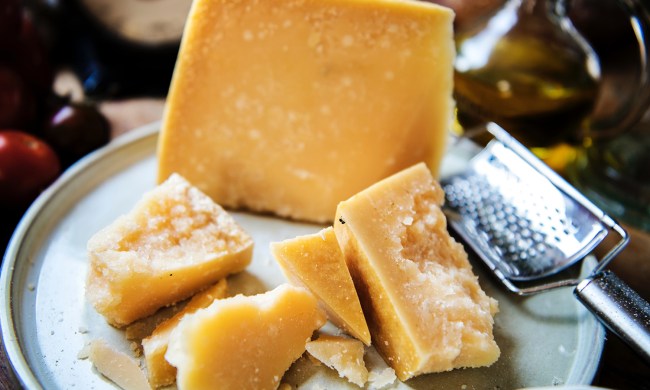I don’t like it when we decide that food needs to follow rules. Even classical French cuisine instructions can, and I argue should, be ignored in the pursuit of something greater. I remember watching an episode of Parts Unknown where Anthony Bourdain watched in horror as a man whisked flour directly into milk to create a sauce, forgoing a roux entirely. And you know what? The sauce came out great.
With that train of thought, I asked myself: why are there seemingly rules around prosciutto? I have to eat it plain or with minimal accompaniments or I am insulting the ingredient, apparently. Somehow this doesn’t apply to its use in sandwiches, mind you, but only if bread isn’t involved. I don’t know why prosciutto gets to be socially placed on this pedestal while we’re over here gleefully adding cream cheese to sushi and then deep frying it, but the more I ask these questions out loud in increasing volume, the more I see a concerned look in my wife’s eyes as she questions my sanity.
Undeterred, I decided to take the burden of culinary ostracism onto myself in the pursuit of greater knowledge. Of the many condiments available to me, what should and should I not pair with the highest quality imported prosciutto I can acquire?
As a baseline, I decided to start with the “acceptable” garnish for prosciutto and work my way through savory choices and up to some sweet offerings. I wanted to find ingredients that were not only widely available, but also had something about them that might work well with the precious pork flavor.
Salt, Pepper, Olive Oil, and Lemon – 5/5
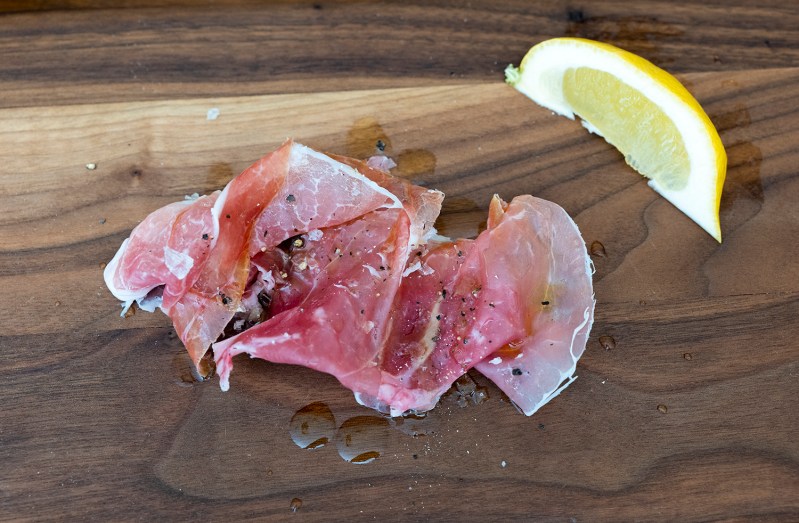
Four ingredients used sparingly atop thinly sliced prosciutto –good olive oil, freshly ground tellicherry black pepper, Maldon salt flakes, and a squeeze of lemon — are apparently all that I am “allowed” to put on prosciutto without raising a fuss. And I have to admit, this combination is difficult to beat. Prosciutto is plenty salty on its own, but the addition of Maldon salt helps elevate the perceived strength of the pepper and lemon without becoming overwhelmingly salty, while the olive oil adds a gentle fruity backbone. The lemon is a nice touch, and gave me a lot of thought into what kinds of other condiments would work well. Before moving ahead with other taste tests, I noted that tart or sour notes would likely do very well with the rich, umami nature of the pork.
Most importantly, the prosciutto is not overpowered in this plating: it is still very much the star here, with the four additional ingredients only adding to the experience.
But I am not satisfied. We must venture further.
Mayonnaise
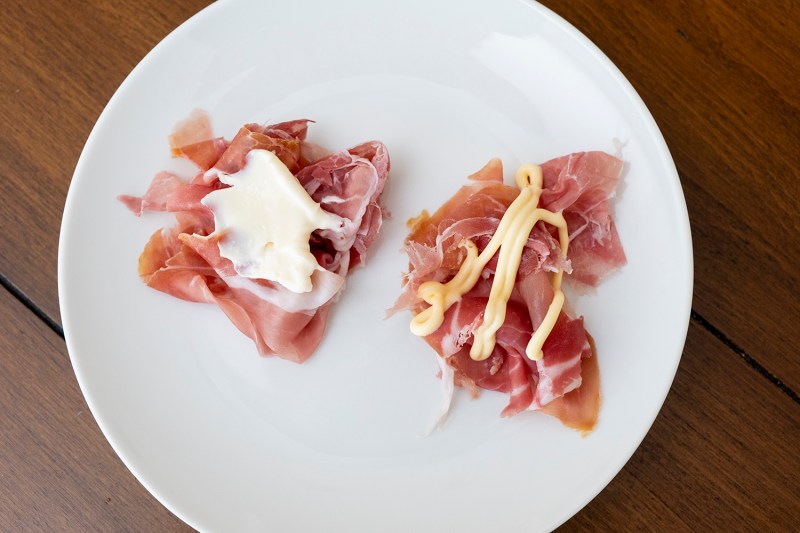
I need to first state that I love mayonnaise: it is my favorite condiment. As such, my expectations were quite high. I decided to try the prosciutto with two types of mayo: The traditional American (Best Foods brand), and Kewpie, a popular Japanese mayonnaise.
American Mayo – 4/5
I must admit, well before embarking on this taste journey, I smeared mayo on prosciutto. Sue me, it’s delicious. Under the microscope of scrutiny, however, it’s not quite as good as the “approved” preparation of salt, pepper, oil, and lemon. It has a lot of those same flavors working together, but it lacks a definitive citrus bite that would really push this over the edge. The creaminess was, however, wonderful. A good start.
Kewpie – 1/5
Kewpie is, for those uninitiated, quite strong. It tastes nothing like American mayonnaise, and the spice mixture that gives Kewpie its signature taste completely overwhelmed the prosciutto. The goal is to enhance the eating experience, now mask it, and the Kewpie fails here.
Mustard
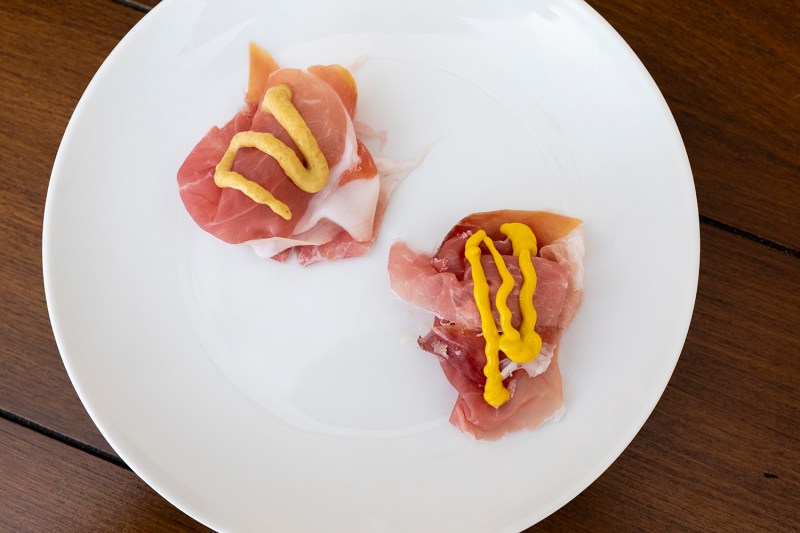
For this test, I tried two different mustards: A good Dijon as well as American Yellow.
Dijon – 2/5
I was pretty disappointed by this, because I thought that Dijon’s mix of savory and tart would go well. Sadly, like the Kewpie before, it was simply too strong. The prosciutto was almost wholly overwhelmed. Much of the nuance of the pork was lost.
American Yellow – 1/5
More than the Dijon, I was really let down by American Yellow here. In my preparation of the BLT, I have found that American Yellow mustard is the best mustard to use. Try it if you haven’t: It’s incredible and really elevates the sandwich. I was hoping that since bacon and prosciutto share their pork heritage, the same would be the case here. It was not. This was very unpleasant and it completely overwhelmed the prosciutto. Additionally, the mustard almost affected the texture, making it feel mushy and sad in my mouth. Dejected by my findings, I pressed on.
Soy Sauce – 4/5
I’m Chinese, so I had to try soy sauce. I went with the best one I had in my cupboard, which is a barrel-aged variety. I am happy to report that this was nearly a match made in heaven. The soy sauce melds its salt and umami nature with the prosciutto’s, which elevates the combination beyond what either is capable of on its own. It’s not perfect though, with tartness or acid lacking here. Ponzu would probably work really well, for those interested in taking other flavors for a test drive themselves.
Trader Joe’s Chili Onion Crunch – 2.5/5
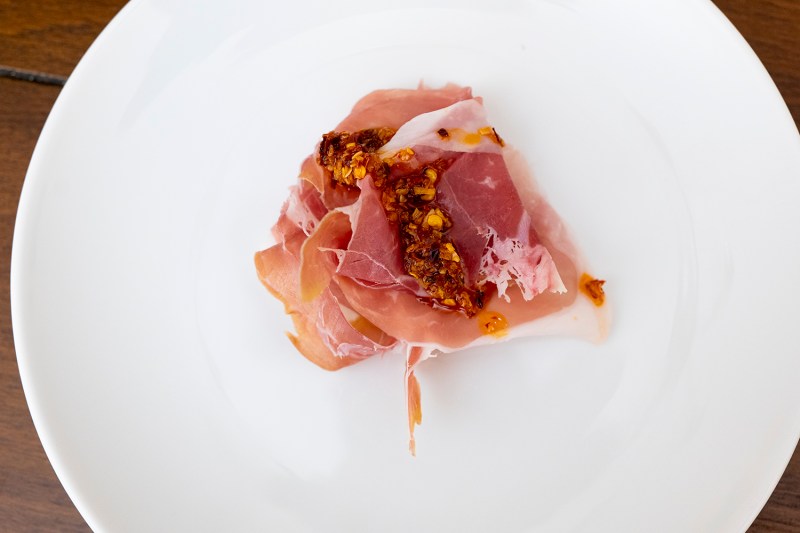
I wanted to see how something spicy played with the aged ham, and unfortunately the answer is “not well.” Prosciutto is subtle, and anything too potent easily overwhelms it. That is the case here, despite Chili Onion Crunch being delicious just about everywhere else.
Cream Cheese – 4/5
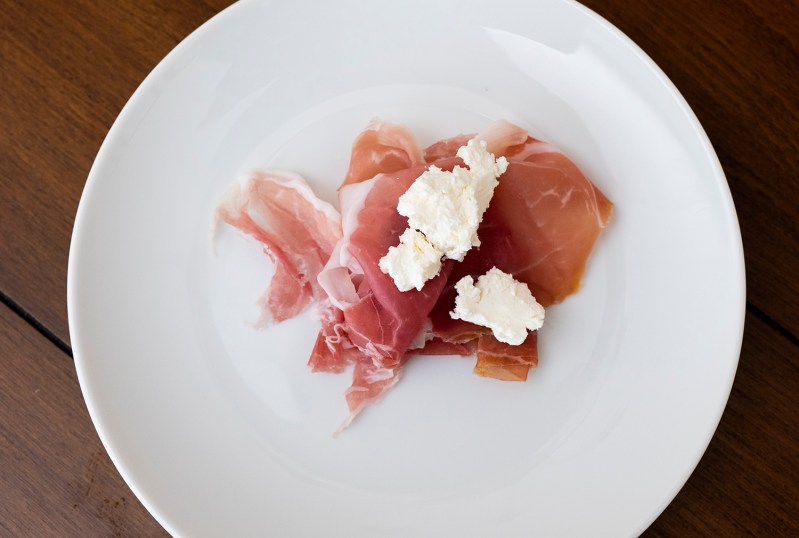
Growing up, I recall one appetizer that involved prosciutto that seemed to be acceptable: smeared with a bit of cream cheese and rolled around asparagus. Apparently the addition of cream cheese to this recipe is unusual, but I went back to those fond memories to see if they hold up today.
They do. Cream cheese works very well with prosciutto, despite lacking any acid. It kind of suffers the same way that the American mayo did, in that it just doesn’t have the tart bite that you need to really appreciate the unctuous nature of the pork. Not perfect, but still great.
Natural Peanut Butter – 3/5
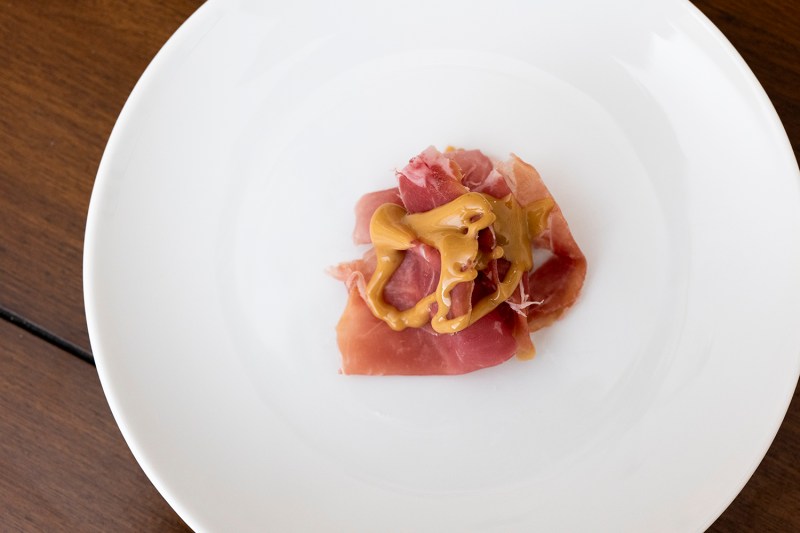
We’re starting to head toward the sweet end of the spectrum, with peanut butter riding that line itself. This combination sound horrible, and I admit it did not start off well. The peanut butter really takes over at first blush, and all you get is the, uh, unique combination of mushy meat and sticky peanut.
But it cleans up as you chew, with the finish being remarkably pleasant. The umami notes of both the peanut and the prosciutto work well together, so it wasn’t wholly bad.
That said, I’m not lining up to try it again.
Ketchup – 2/5
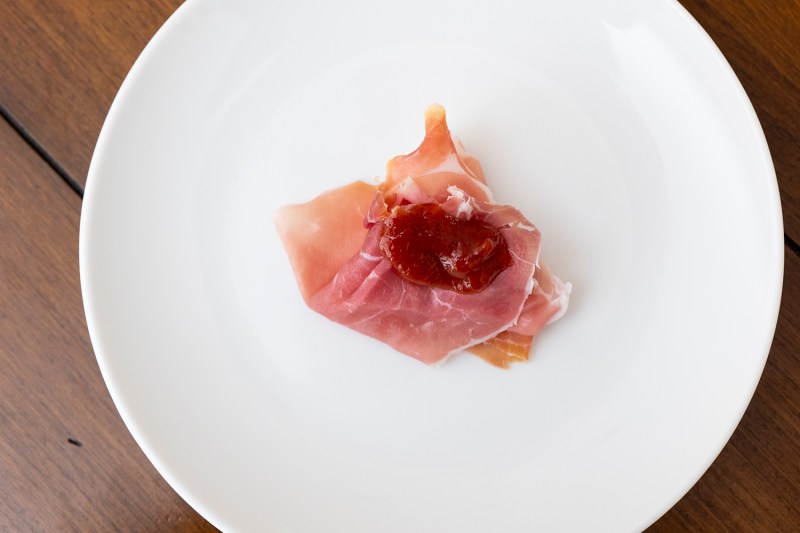
First and foremost, I should mention that as much as I love mayonnaise, I despise ketchup. Ketchup is the worst, and to be avoided nearly all the time. I don’t even know why I have any in my refrigerator at all.
Anyway, this was pretty freaking awful. Ketchup is way too aggressive up front, but the fact that it gives way to a mild sweetness saves this from the same score that plagues Kewpie. As it finishes, that sweetness reveals more of the salty nature of the pork than I anticipated and while it was overall heinous and foul, I have to give that sweetness a bit of credit.
Fruit Pastes
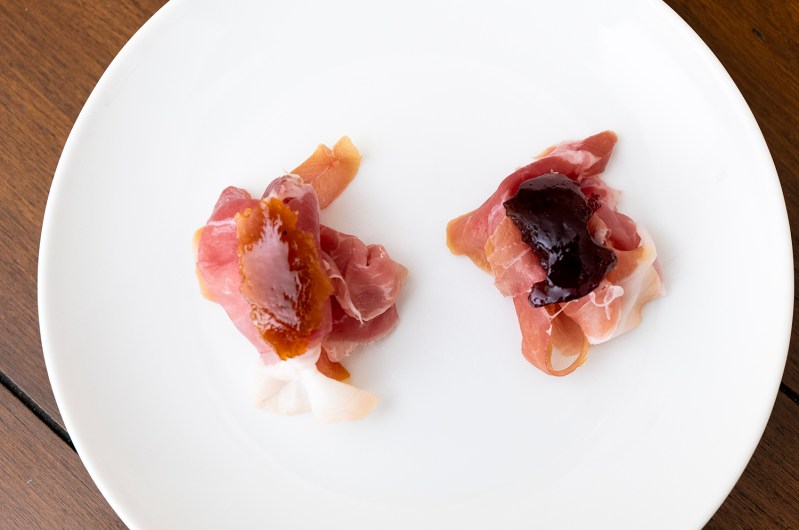
In this test, I grabbed the cheese board favorite quince paste as well as a sour cherry jam. Since lemon is a fruit and that was a major player in why the classical preparation is so good, I had high hopes for these.
Quince Paste – 4/5
Quince is really quite mild, with a subtle sweetness and a savory backbone despite its overall sweet profile. That mixed very well with the prosciutto, though I found the texture of quince to be a bit mealy which, sadly, goes quite poorly with prosciutto, which likes to go mushy while you chew it. The biggest failing of the quince, though, was its lack of acid.
Sour Cherry Jam – 5/5
I don’t think it can get much better than this: Sour cherry is a home run. I think in my search for all flavors that go well with prosciutto, it was worth enduring the worst in my taste tests (like ketchup and Kewpie) if it meant ending up at sour cherry. The sourness mimics the acid boost that you get from lemon, but the sweetness played remarkably well with the salt and umami from the prosciutto. Instead of having to add more salt to really pump up the flavor volume, the sweetness bounces off the prosciutto’s natural saltiness and elevates the flavor there. The result is a very well-rounded bite that I think would play well on any platter. Seriously, try this.
So if this worked, what if we went even sweeter?
Maple Syrup – 4.5/5
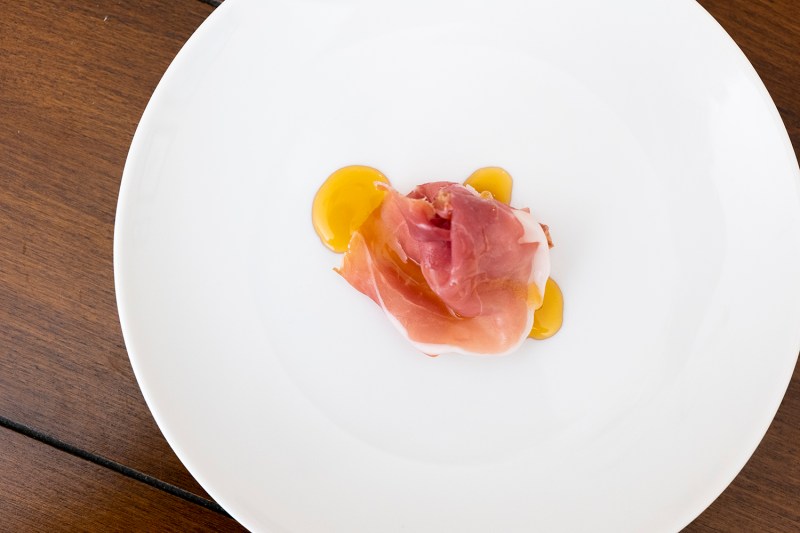
Coming in as a close second to the sour cherry jam, maple syrup was a surprisingly excellent pairing with prosciutto. I thought for sure that the aggressively strong nature of maple would take over, but it really played quite nicely. As with the cherry jam, the sweetness really helped pump up the flavor of the prosciutto, while the maple’s subtle savory undertones meshed well with the ham. It doesn’t quite get full marks, though, as the maple did want to play lead singer a bit too strongly. It didn’t overwhelm, but it came too close to get my full recommendation.
Nutella – 3/5
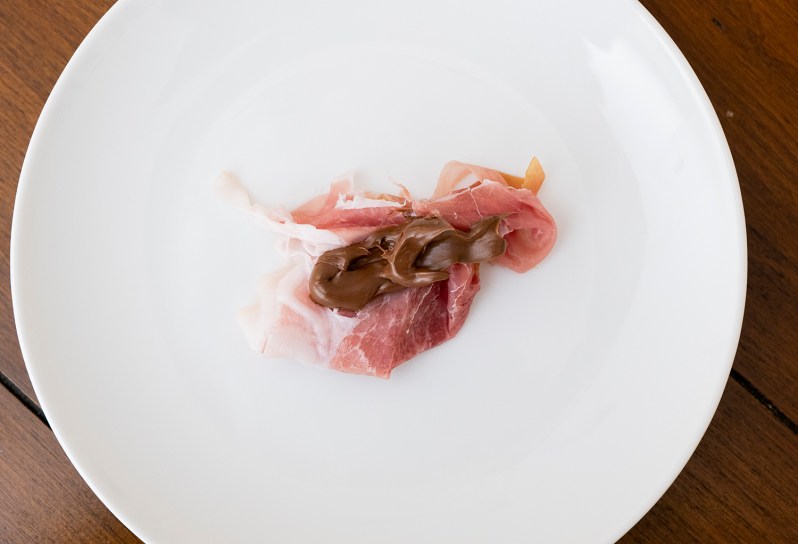
When I first set out all my condiments, I felt for sure Nutella would be the worst one. The idea of chocolate, hazelnut, and that sickly sweet taste would just not go well. I’m even making a face right now as I think about it.
But weirdly, it almost works.
The Nutella is, unfortunately, too strong and will overwhelm the prosciutto. The flavors want to work, you can tell, but the Nutella’s chocolate and sweetness just never fully let the ham flavor develop before the bite is done. I think there is hope here for a homemade Nutella spread that has less sugar, but the store-bought stuff is unfortunately too strong.
Now here I sit, a ball of meat and condiments resting in my tummy, at the conclusion of my journey. I’ve got the meat sweats and my stomach hurts, yet I am victorious. Prosciutto is a wonderful product that deserves some measure of honor, but that shouldn’t prevent us from trying new things with it. If it wasn’t for the ketchup, the peanut butter or the Nutella, we would not have discovered the soy sauce or sour cherry jam. We must take those lows with the highs.
Now please excuse me, I need a nap.
Jaron Schneider is a classically trained chef with over 15 years of experience behind the stove with particular emphasis in classical Tuscan and New American cuisine.


